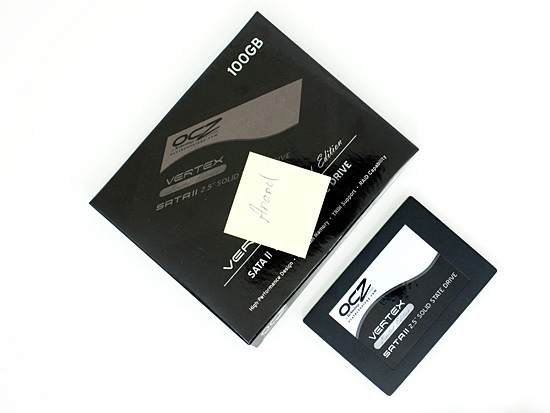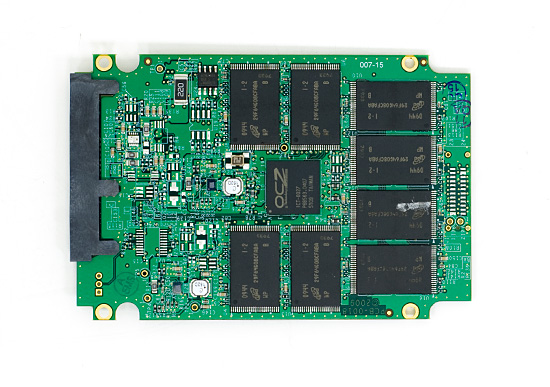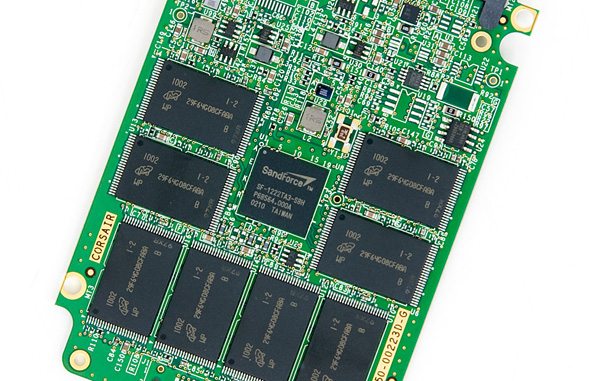Understanding SandForce's SF-1200 & SF-1500, Not All Drives are Equal
by Anand Lal Shimpi on April 16, 2010 11:30 AM ESTLess than 24 hours ago I was called into a meeting with SandForce, the SSD controller manufacturer that has been on fire lately. The company makes two controllers: the SF-1200 and SF-1500. The meeting was initiated by SandForce to clear up any misconceptions I might have about the differences between the two controllers. No good deed goes unpunished, and the quick meeting turned into an hour long debate about responsibility and ethics. It turns out that while I finally know the difference between the SF-1200 and the more expensive SF-1500, not all drives based on the SF-1200 will offer the same performance. In fact, some drives that are currently on the market will actually drop in performance (in one metric) if you upgrade them to SF’s mass production firmware. Yep.

SF-1200 vs. SF-1500
On SandForce’s site are two controller options: the SF-1500 intended for enterprise (server) customers, and the SF-1200 for client (desktop/notebook) SSDs. The first silicon ready was SF-1500, and a derivative version of that was used in the earliest drives (e.g. OCZ’s Vertex Limited Edition). More recently however we’ve seen SF-1200 based SSDs crop up, such as Corsair’s Force drive. In our recent review we found no performance difference between the Force drive and the Vertex LE, leading me to believe that there’s no tangible performance difference between the SF-1200 and SF-1500. However since then I’ve finally got a good handle on the differences directly from SandForce.

The SF-1500 controller from the original Vertex LE.
Let’s start with the obvious and what I suspected: there is no physical difference between the SF-1200 and SF-1500. It’s the same die. The difference between the two amounts to firmware, validation and settings on the chips themselves. It’s akin to Intel disabling Hyper Threading on the Core i5 750 but leaving it enabled on the Core i7 860; same die, different features.

The SF-1200 controller on Corsair's Force SSD. The chips are the same, it's all about firmware and settings.
As an enterprise class solution, the SF-1500 is designed to complete any writes in progress in the event of sudden power loss. The SF-1500 firmware is configured expecting the presence of the super cap we saw in the Vertex 2 Pro. As such it expects that it can write at full speed without any worries about power loss. In other words, it assumes you have power failure protection at the drive level.
The SF-1200 firmware on the other hand doesn’t assume the presence of a large capacitor to keep the controller/NAND powered long enough to complete all writes in the event of a power failure. As such it does more frequent check pointing and doesn’t guarantee the write in progress will complete before it’s acknowledged. It’s a subtle difference, but the SF-1500 with super cap may be necessary for some of SandForce’s enterprise customers.

The SF-1500's super cap, necessary because SandForce's controller keeps a couple of MBs of data buffered
Continuing the enterprise focus, the SF-1500 supports more SMART attributes and logging/debug/diagnostic features. SandForce wasn’t willing to elaborate on this point but said that it shares the SMART feature list with its customers under NDA. If this sort of thing might matter to you, sign a NDA with SandForce and they’ll apparently tell all.
As I pointed out in the Corsair Force review, SandForce rates the SF-1500 for a longer mean time to failure than the SF-1200. This is a basic binning/testing advantage. The SF-1500 goes through more tests and qualification than the SF-1200 allowing SandForce to guarantee higher reliability. That’s not to say that the SF-1200 won’t last as long as or longer than the SF-1500, it’s just that SandForce is willing to guarantee a longer lifespan on the SF-1500 than it is willing to do for the SF-1200. I poked fun at SF’s mean time to failure ratings in the Force review, however SandForce explained the MTTF is calculated across the entire population of controllers - not the lifespan of a single controller.
In a population of 10,000,000 controllers, with a rating of 10,000,000 hours, the probability is that 1 unit would fail in an hour. The SF-1200 would have 5 units fail in the same time. The failure probability drops as the number of controllers drops (SF won’t be shipping anywhere near 10M of these things).
While both the SF-1200 and SF-1500 support MLC NAND, the SF-1500 also supports SLC. This once again is more of an enterprise class feature as most desktop users aren’t willing to pay the 2x price premium of SLC vs. MLC NAND flash.
| SandForce Controller Comparison | ||||
| SF-1200 | SF-1500 | |||
| Flash Memory Support | MLC | MLC or SLC | ||
| Power Consumption | 550 mW (typical) | 950 mW (typical) | ||
| Sequential Read/Write Performance (128KB) | 260 MB/s | 260 MB/s | ||
| Random Read/Write Performance (4K) | 30K/10K IOPS | 30K/30K IOPS | ||
| Security | 128-bit AES Data Encryption, Optional Disk Password | 128-bit AES Data Encryption, User Selectable Encryption Key | ||
| Unrecoverable Read Errors | Less than 1 sector per 1016 bits read | Less than 1 sector per 1017 bits read | ||
| MTTF | 2,000,000 operating hours | 10,000,000 operating hours | ||
| Reliability | 5 year customer life cycle | 5 year enterprise life cycle | ||
So far none of these differences matter to a client user, but the last item on the list does. There’s a performance difference between the SF-1200 and SF-1500. The SF-1500 is capable of higher sustained small file random write speed. The SF-1200 is rated at 10,000 4K random write IOPS (sustained), while the SF-1500 is rated at 30K (sustained). This is purely a firmware limitation, but SandForce believes the 10K number is high enough for client PCs (Intel rates its X25-M G2 at 6.6K for the 80GB model and 8.6K for the 160GB model).
The controllers should otherwise perform the same, it’s only in small file random writes that there’s a difference (realistically speaking we’re talking random writes smaller than 16KB in size). SandForce notes the difference on its website, however in our testing of Corsair’s Force drive we showed absolutely no difference. So what’s going on?










81 Comments
View All Comments
cactusdog - Friday, April 16, 2010 - link
I hope this isnt a case of bait and switch. Did they make a few parts with the quality controller then once the reviews are up switch to the cheaper controller for the masses? We've seen it before.....aconu - Saturday, April 17, 2010 - link
HelloI purchase an 200GB OWC drive the first day of their availability.
Unfortunately, i encountered troubles with the drive (growing I/O errors over one week of use, until heavy data corruption and unbootable OS). After tree secure erases, and tree weeks of repeated symptoms, i decided to return the SSD.
The drive was unavailable until yesterday, and suddenly the specs changes.
That's mean OWC will going to replace my drive with a lower specs one ?
willscary - Saturday, April 17, 2010 - link
I was told that ALL Mercury Extreme SSDs now utilize the Sandforce 1200 controller.eva2000 - Saturday, April 17, 2010 - link
Thanks Anand great info, saved me alot of $$$ as i wait and see, already got a 256GB Crucial C300. Was thinking of getting OWC 100/200GB but last month emailed them to ask about their units and compatibility list and they said they mainly cater to Mac users so OWC SSD has no guarantee for compatibility on PC systems. That already put me off unfortunately.skimike - Tuesday, June 15, 2010 - link
How did you perform your secure erase? The last time I contacted OWC about ANY utilities for the Mercury Extreme drives, their tech support had no clue. They didn't even know what a secure erase was. The guy I talked to told me to "write 0's to the entire drive".et01267 - Sunday, April 18, 2010 - link
Interesting, I also ordered the 200GB Mercury extreme from OWC/Macsales a couple of days ago and there was a delay in availability (and then the specs on the site were changed). However, my invoice states:200GB OWC Mercury ExtremeSSD EntRAID 200GB Mercury Extreme RAID-Ready Enterprise Class SSD 2.5" Serial-ATA 9.5mm Solid State Drive. High Performance internal storage. Fastest read and write times of any SSD available today! 10 million hours MTBF. 5 Year OWC Warranty.
So, did will I get a Sandforce 1500 or 1200 controller? I should find out tomorrow when it arrives.
In the meantime, I'd appreciate you putting me in touch with your contacts at OWC.
Thanks for the informative, if somewhat ill-timed (for me) article.
willscary - Monday, April 19, 2010 - link
This was exactly what happened to me. Check with the website and see what their current specs are. I was in the exact same boat and my SSDs had already shipped. When I called OWC, it took a while, but they did admit that all Mercury Extremes are now utilizing the Sandforce 1200 controller. They got their product reviewed glowingly with one controller and used that controllers specifications, then changed hardware without telling those of us who had already purchased and were waiting for delivery. I was upset about the deception and the failure to offer a discount, as the 1200 costs $100-150 less than the 1500 (per Digitalloyd's update from yesterday). By the way, this digitalloyd seems to have NO problem with this practice!bludragon - Friday, April 16, 2010 - link
"In a population of 10,000,000 controllers, with a rating of 10,000,000 hours, the probability is that 1 unit would fail in an hour. The SF-1200 would have 5 units fail in the same time. The failure probability drops as the number of controllers drops (SF won’t be shipping anywhere near 10M of these things)."This make no sense as it implies that somehow sandforce producing more controllers after they shipped mine is going to reduce the lifetime of my controller.
I think what you mean is that MTBF is listed for a single device. If I use 2, then the MTBF of the 2 combined will halve, and so having such high figures is relevant.
Lifted - Friday, April 16, 2010 - link
MTBF is meaningless with 1 or 2 drives. It's meant for large Enterprise customers and data centers where they may have thousands of drives. These customers need to know how often to expect drive failures in order to know how many resources need to be dedicated to this (personnel and spare drives).The strange thing is that Anand has been reviewing hard drives and SSD's for so many years now, with direct access to the manufacturers, but he never once asked what MTBF was. Why did he only find it strange now when hard drives have always had 1,000,000+ hour MTBF ratings?
Anyway, nice article. Keep them coming.
pzkfwg - Friday, April 16, 2010 - link
I suppose this stat can be converted into a probability which would be relevant to a single drive. Indeed, saying that "1 drive out of 10,000,000 will die within an hour of operation" means exactly the same thing as "you have 0,00001% chance of having your single drive dying within its first hour of operation" which is kind of relevant to a single drive and isn't linked to the number of controllers produced by SandForce.Out of this number, there is probably a way to have a more useful probability such as the chance of having your drive fail within its first two years of operation, but I don't know how to compute it (maybe a so called "normal" distribution or something would be the key).